GMC SIERRA 2006 Owner's Manual
Manufacturer: GMC, Model Year: 2006, Model line: SIERRA, Model: GMC SIERRA 2006Pages: 600, PDF Size: 3.49 MB
Page 581 of 600
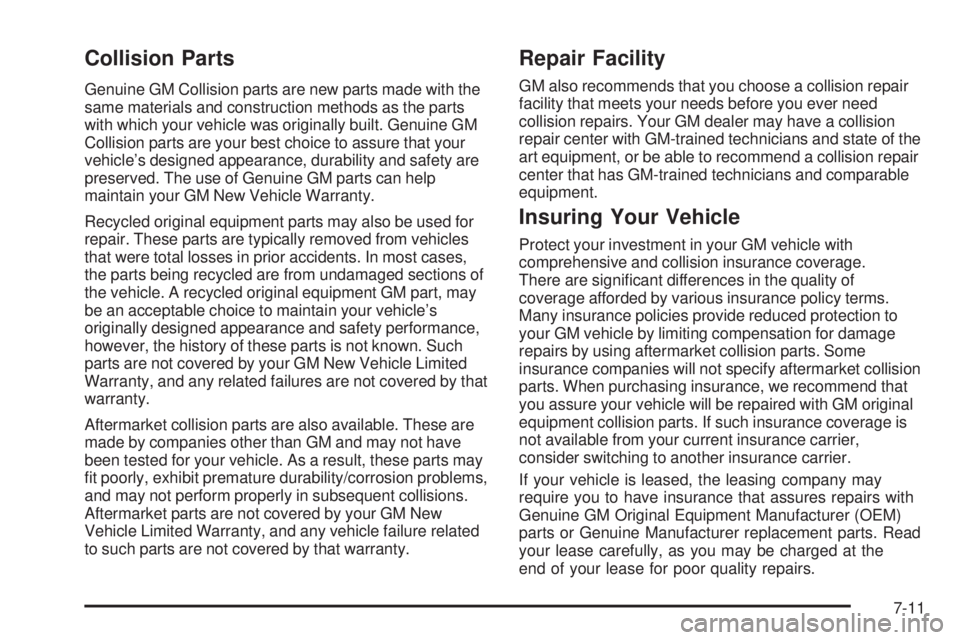
Collision Parts
Genuine GM Collision parts are new parts made with the
same materials and construction methods as the parts
with which your vehicle was originally built. Genuine GM
Collision parts are your best choice to assure that your
vehicle’s designed appearance, durability and safety are
preserved. The use of Genuine GM parts can help
maintain your GM New Vehicle Warranty.
Recycled original equipment parts may also be used for
repair. These parts are typically removed from vehicles
that were total losses in prior accidents. In most cases,
the parts being recycled are from undamaged sections of
the vehicle. A recycled original equipment GM part, may
be an acceptable choice to maintain your vehicle’s
originally designed appearance and safety performance,
however, the history of these parts is not known. Such
parts are not covered by your GM New Vehicle Limited
Warranty, and any related failures are not covered by that
warranty.
Aftermarket collision parts are also available. These are
made by companies other than GM and may not have
been tested for your vehicle. As a result, these parts may
�t poorly, exhibit premature durability/corrosion problems,
and may not perform properly in subsequent collisions.
Aftermarket parts are not covered by your GM New
Vehicle Limited Warranty, and any vehicle failure related
to such parts are not covered by that warranty.
Repair Facility
GM also recommends that you choose a collision repair
facility that meets your needs before you ever need
collision repairs. Your GM dealer may have a collision
repair center with GM-trained technicians and state of the
art equipment, or be able to recommend a collision repair
center that has GM-trained technicians and comparable
equipment.
Insuring Your Vehicle
Protect your investment in your GM vehicle with
comprehensive and collision insurance coverage.
There are signi�cant differences in the quality of
coverage afforded by various insurance policy terms.
Many insurance policies provide reduced protection to
your GM vehicle by limiting compensation for damage
repairs by using aftermarket collision parts. Some
insurance companies will not specify aftermarket collision
parts. When purchasing insurance, we recommend that
you assure your vehicle will be repaired with GM original
equipment collision parts. If such insurance coverage is
not available from your current insurance carrier,
consider switching to another insurance carrier.
If your vehicle is leased, the leasing company may
require you to have insurance that assures repairs with
Genuine GM Original Equipment Manufacturer (OEM)
parts or Genuine Manufacturer replacement parts. Read
your lease carefully, as you may be charged at the
end of your lease for poor quality repairs.
7-11
Page 582 of 600
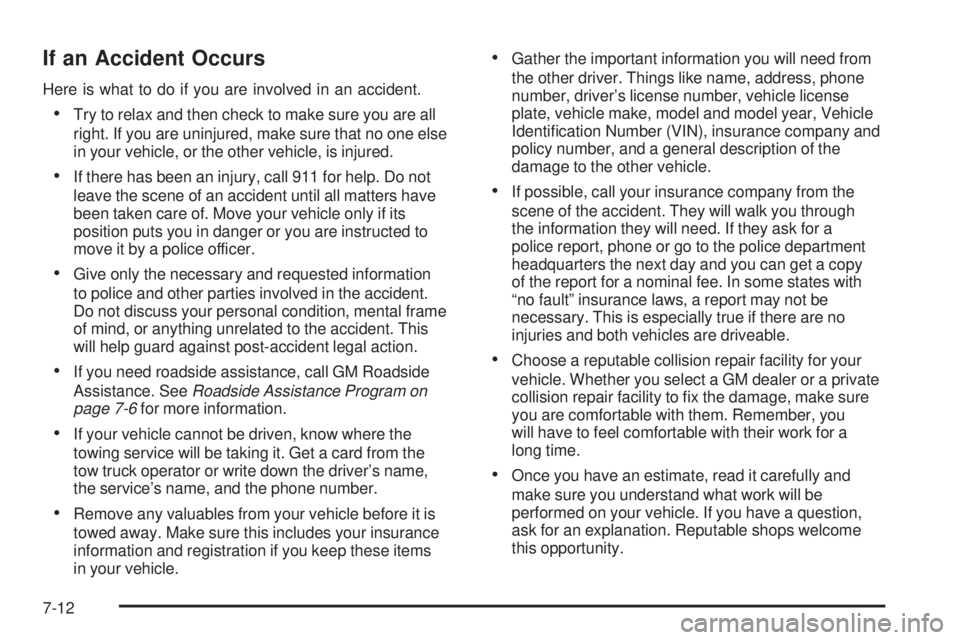
If an Accident Occurs
Here is what to do if you are involved in an accident.
Try to relax and then check to make sure you are all
right. If you are uninjured, make sure that no one else
in your vehicle, or the other vehicle, is injured.
If there has been an injury, call 911 for help. Do not
leave the scene of an accident until all matters have
been taken care of. Move your vehicle only if its
position puts you in danger or you are instructed to
move it by a police officer.
Give only the necessary and requested information
to police and other parties involved in the accident.
Do not discuss your personal condition, mental frame
of mind, or anything unrelated to the accident. This
will help guard against post-accident legal action.
If you need roadside assistance, call GM Roadside
Assistance. SeeRoadside Assistance Program on
page 7-6for more information.
If your vehicle cannot be driven, know where the
towing service will be taking it. Get a card from the
tow truck operator or write down the driver’s name,
the service’s name, and the phone number.
Remove any valuables from your vehicle before it is
towed away. Make sure this includes your insurance
information and registration if you keep these items
in your vehicle.
Gather the important information you will need from
the other driver. Things like name, address, phone
number, driver’s license number, vehicle license
plate, vehicle make, model and model year, Vehicle
Identi�cation Number (VIN), insurance company and
policy number, and a general description of the
damage to the other vehicle.
If possible, call your insurance company from the
scene of the accident. They will walk you through
the information they will need. If they ask for a
police report, phone or go to the police department
headquarters the next day and you can get a copy
of the report for a nominal fee. In some states with
“no fault” insurance laws, a report may not be
necessary. This is especially true if there are no
injuries and both vehicles are driveable.
Choose a reputable collision repair facility for your
vehicle. Whether you select a GM dealer or a private
collision repair facility to �x the damage, make sure
you are comfortable with them. Remember, you
will have to feel comfortable with their work for a
long time.
Once you have an estimate, read it carefully and
make sure you understand what work will be
performed on your vehicle. If you have a question,
ask for an explanation. Reputable shops welcome
this opportunity.
7-12
Page 583 of 600
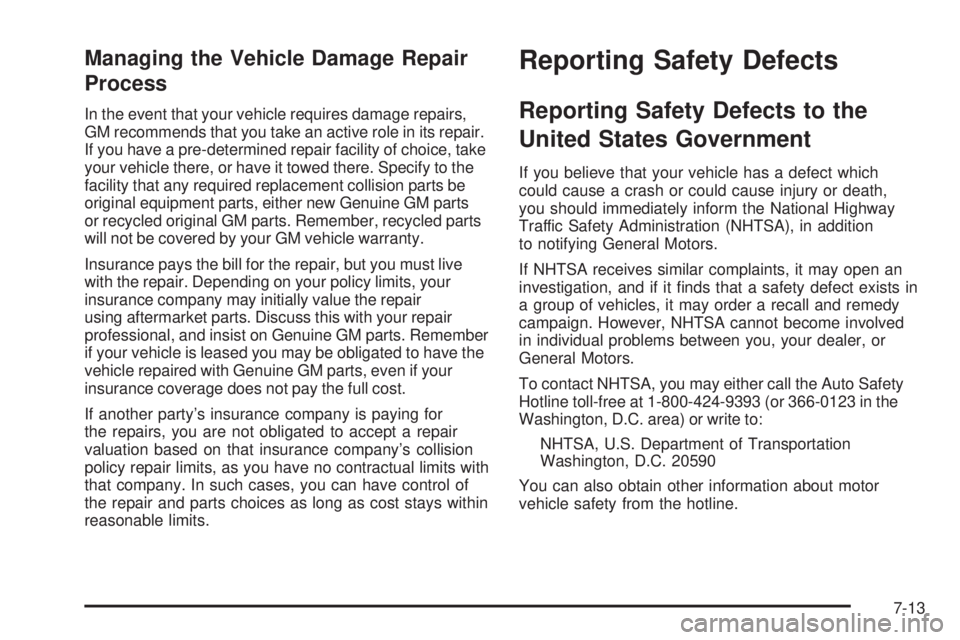
Managing the Vehicle Damage Repair
Process
In the event that your vehicle requires damage repairs,
GM recommends that you take an active role in its repair.
If you have a pre-determined repair facility of choice, take
your vehicle there, or have it towed there. Specify to the
facility that any required replacement collision parts be
original equipment parts, either new Genuine GM parts
or recycled original GM parts. Remember, recycled parts
will not be covered by your GM vehicle warranty.
Insurance pays the bill for the repair, but you must live
with the repair. Depending on your policy limits, your
insurance company may initially value the repair
using aftermarket parts. Discuss this with your repair
professional, and insist on Genuine GM parts. Remember
if your vehicle is leased you may be obligated to have the
vehicle repaired with Genuine GM parts, even if your
insurance coverage does not pay the full cost.
If another party’s insurance company is paying for
the repairs, you are not obligated to accept a repair
valuation based on that insurance company’s collision
policy repair limits, as you have no contractual limits with
that company. In such cases, you can have control of
the repair and parts choices as long as cost stays within
reasonable limits.
Reporting Safety Defects
Reporting Safety Defects to the
United States Government
If you believe that your vehicle has a defect which
could cause a crash or could cause injury or death,
you should immediately inform the National Highway
Traffic Safety Administration (NHTSA), in addition
to notifying General Motors.
If NHTSA receives similar complaints, it may open an
investigation, and if it �nds that a safety defect exists in
a group of vehicles, it may order a recall and remedy
campaign. However, NHTSA cannot become involved
in individual problems between you, your dealer, or
General Motors.
To contact NHTSA, you may either call the Auto Safety
Hotline toll-free at 1-800-424-9393 (or 366-0123 in the
Washington, D.C. area) or write to:
NHTSA, U.S. Department of Transportation
Washington, D.C. 20590
You can also obtain other information about motor
vehicle safety from the hotline.
7-13
Page 584 of 600
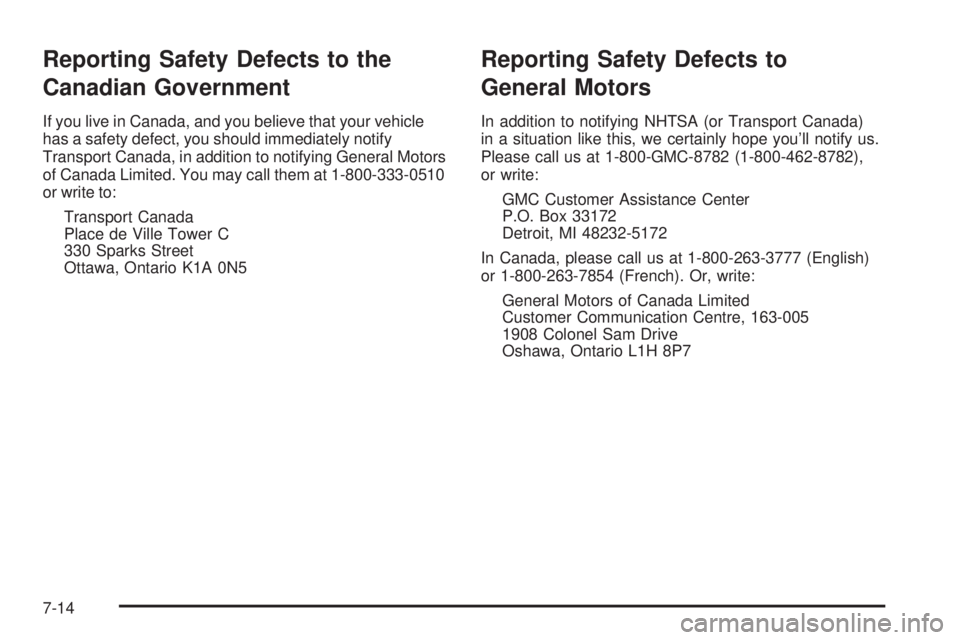
Reporting Safety Defects to the
Canadian Government
If you live in Canada, and you believe that your vehicle
has a safety defect, you should immediately notify
Transport Canada, in addition to notifying General Motors
of Canada Limited. You may call them at 1-800-333-0510
or write to:
Transport Canada
Place de Ville Tower C
330 Sparks Street
Ottawa, Ontario K1A 0N5
Reporting Safety Defects to
General Motors
In addition to notifying NHTSA (or Transport Canada)
in a situation like this, we certainly hope you’ll notify us.
Please call us at 1-800-GMC-8782 (1-800-462-8782),
or write:
GMC Customer Assistance Center
P.O. Box 33172
Detroit, MI 48232-5172
In Canada, please call us at 1-800-263-3777 (English)
or 1-800-263-7854 (French). Or, write:
General Motors of Canada Limited
Customer Communication Centre, 163-005
1908 Colonel Sam Drive
Oshawa, Ontario L1H 8P7
7-14
Page 585 of 600
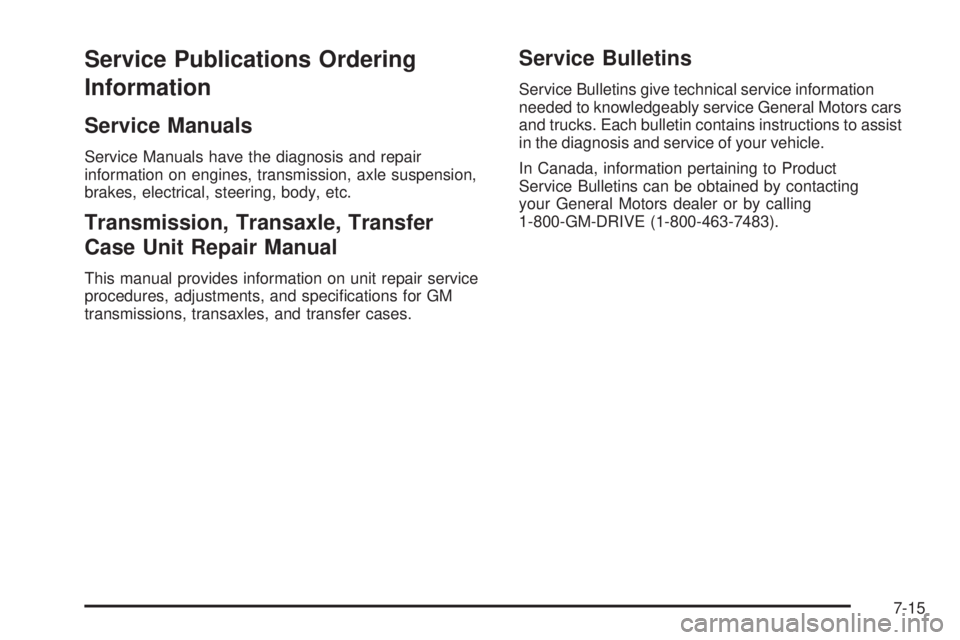
Service Publications Ordering
Information
Service Manuals
Service Manuals have the diagnosis and repair
information on engines, transmission, axle suspension,
brakes, electrical, steering, body, etc.
Transmission, Transaxle, Transfer
Case Unit Repair Manual
This manual provides information on unit repair service
procedures, adjustments, and speci�cations for GM
transmissions, transaxles, and transfer cases.
Service Bulletins
Service Bulletins give technical service information
needed to knowledgeably service General Motors cars
and trucks. Each bulletin contains instructions to assist
in the diagnosis and service of your vehicle.
In Canada, information pertaining to Product
Service Bulletins can be obtained by contacting
your General Motors dealer or by calling
1-800-GM-DRIVE (1-800-463-7483).
7-15
Page 586 of 600
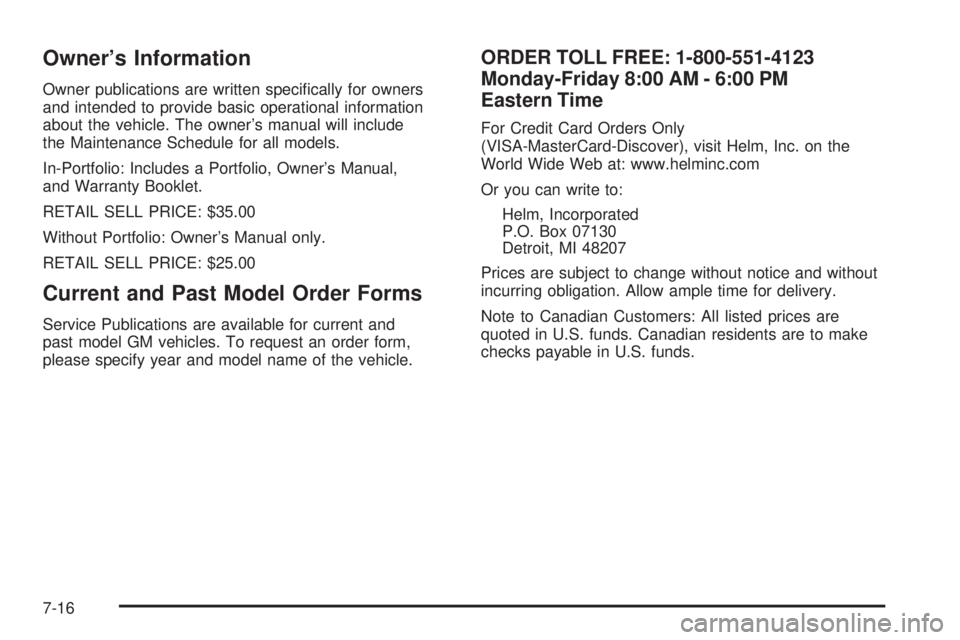
Owner’s Information
Owner publications are written speci�cally for owners
and intended to provide basic operational information
about the vehicle. The owner’s manual will include
the Maintenance Schedule for all models.
In-Portfolio: Includes a Portfolio, Owner’s Manual,
and Warranty Booklet.
RETAIL SELL PRICE: $35.00
Without Portfolio: Owner’s Manual only.
RETAIL SELL PRICE: $25.00
Current and Past Model Order Forms
Service Publications are available for current and
past model GM vehicles. To request an order form,
please specify year and model name of the vehicle.
ORDER TOLL FREE: 1-800-551-4123
Monday-Friday 8:00 AM - 6:00 PM
Eastern Time
For Credit Card Orders Only
(VISA-MasterCard-Discover), visit Helm, Inc. on the
World Wide Web at: www.helminc.com
Or you can write to:
Helm, Incorporated
P.O. Box 07130
Detroit, MI 48207
Prices are subject to change without notice and without
incurring obligation. Allow ample time for delivery.
Note to Canadian Customers: All listed prices are
quoted in U.S. funds. Canadian residents are to make
checks payable in U.S. funds.
7-16
Page 587 of 600
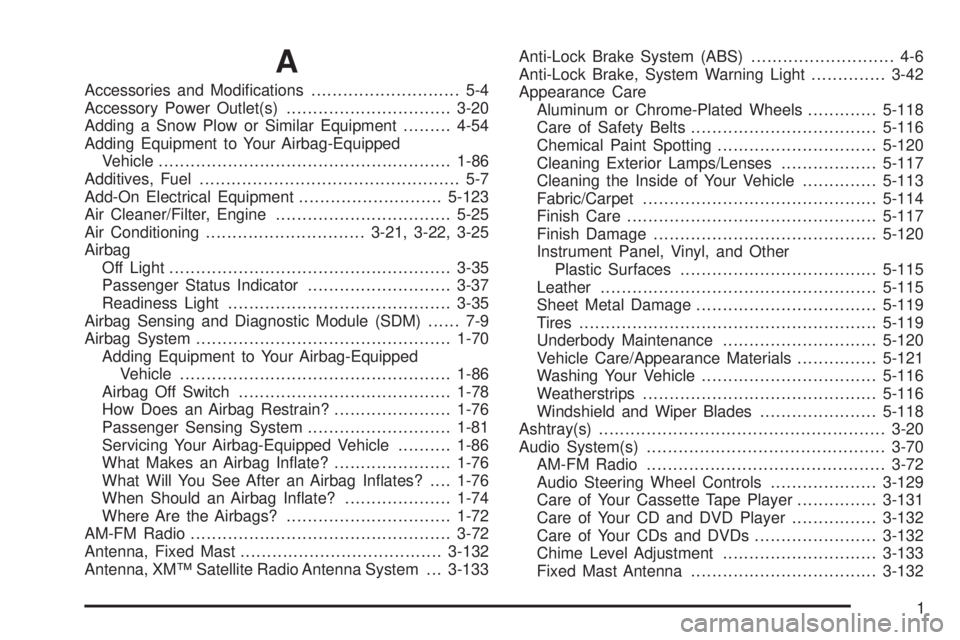
A
Accessories and Modi�cations............................ 5-4
Accessory Power Outlet(s)...............................3-20
Adding a Snow Plow or Similar Equipment.........4-54
Adding Equipment to Your Airbag-Equipped
Vehicle.......................................................1-86
Additives, Fuel................................................. 5-7
Add-On Electrical Equipment...........................5-123
Air Cleaner/Filter, Engine.................................5-25
Air Conditioning..............................3-21, 3-22, 3-25
Airbag
Off Light.....................................................3-35
Passenger Status Indicator...........................3-37
Readiness Light..........................................3-35
Airbag Sensing and Diagnostic Module (SDM)...... 7-9
Airbag System................................................1-70
Adding Equipment to Your Airbag-Equipped
Vehicle...................................................1-86
Airbag Off Switch........................................1-78
How Does an Airbag Restrain?......................1-76
Passenger Sensing System...........................1-81
Servicing Your Airbag-Equipped Vehicle..........1-86
What Makes an Airbag In�ate?......................1-76
What Will You See After an Airbag In�ates?....1-76
When Should an Airbag In�ate?....................1-74
Where Are the Airbags?...............................1-72
AM-FM Radio.................................................3-72
Antenna, Fixed Mast......................................3-132
Antenna, XM™ Satellite Radio Antenna System . . . 3-133Anti-Lock Brake System (ABS)........................... 4-6
Anti-Lock Brake, System Warning Light..............3-42
Appearance Care
Aluminum or Chrome-Plated Wheels.............5-118
Care of Safety Belts...................................5-116
Chemical Paint Spotting..............................5-120
Cleaning Exterior Lamps/Lenses..................5-117
Cleaning the Inside of Your Vehicle..............5-113
Fabric/Carpet............................................5-114
Finish Care...............................................5-117
Finish Damage..........................................5-120
Instrument Panel, Vinyl, and Other
Plastic Surfaces.....................................5-115
Leather....................................................5-115
Sheet Metal Damage..................................5-119
Tires........................................................5-119
Underbody Maintenance.............................5-120
Vehicle Care/Appearance Materials...............5-121
Washing Your Vehicle.................................5-116
Weatherstrips............................................5-116
Windshield and Wiper Blades......................5-118
Ashtray(s)......................................................3-20
Audio System(s).............................................3-70
AM-FM Radio.............................................3-72
Audio Steering Wheel Controls....................3-129
Care of Your Cassette Tape Player...............3-131
Care of Your CD and DVD Player................3-132
Care of Your CDs and DVDs.......................3-132
Chime Level Adjustment.............................3-133
Fixed Mast Antenna...................................3-132
1
Page 588 of 600
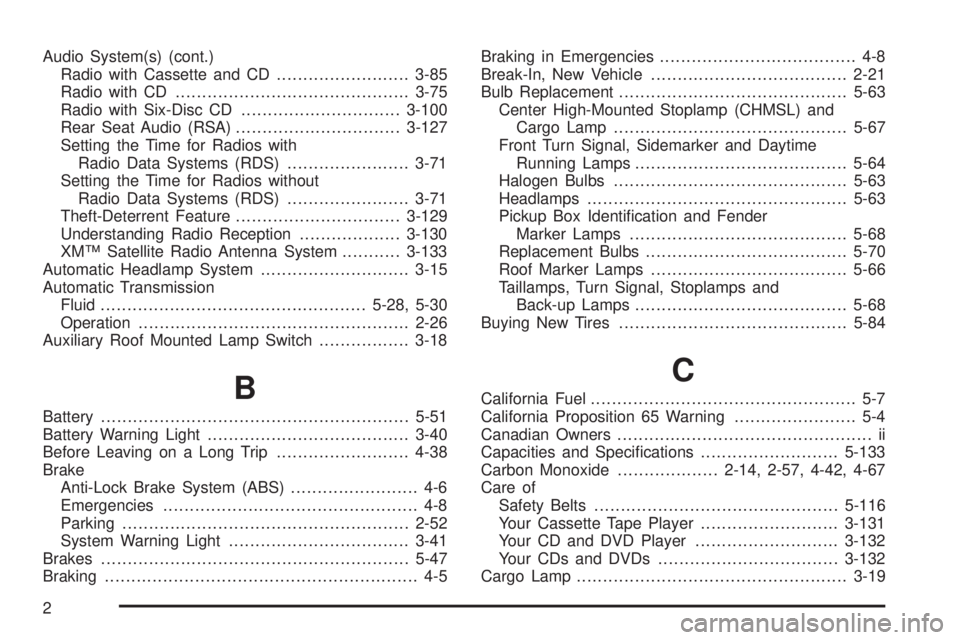
Audio System(s) (cont.)
Radio with Cassette and CD.........................3-85
Radio with CD............................................3-75
Radio with Six-Disc CD..............................3-100
Rear Seat Audio (RSA)...............................3-127
Setting the Time for Radios with
Radio Data Systems (RDS).......................3-71
Setting the Time for Radios without
Radio Data Systems (RDS).......................3-71
Theft-Deterrent Feature...............................3-129
Understanding Radio Reception...................3-130
XM™ Satellite Radio Antenna System...........3-133
Automatic Headlamp System............................3-15
Automatic Transmission
Fluid..................................................5-28, 5-30
Operation...................................................2-26
Auxiliary Roof Mounted Lamp Switch.................3-18
B
Battery..........................................................5-51
Battery Warning Light......................................3-40
Before Leaving on a Long Trip.........................4-38
Brake
Anti-Lock Brake System (ABS)........................ 4-6
Emergencies................................................ 4-8
Parking......................................................2-52
System Warning Light..................................3-41
Brakes..........................................................5-47
Braking........................................................... 4-5Braking in Emergencies..................................... 4-8
Break-In, New Vehicle.....................................2-21
Bulb Replacement...........................................5-63
Center High-Mounted Stoplamp (CHMSL) and
Cargo Lamp............................................5-67
Front Turn Signal, Sidemarker and Daytime
Running Lamps........................................5-64
Halogen Bulbs............................................5-63
Headlamps.................................................5-63
Pickup Box Identi�cation and Fender
Marker Lamps.........................................5-68
Replacement Bulbs......................................5-70
Roof Marker Lamps.....................................5-66
Taillamps, Turn Signal, Stoplamps and
Back-up Lamps........................................5-68
Buying New Tires...........................................5-84
C
California Fuel.................................................. 5-7
California Proposition 65 Warning....................... 5-4
Canadian Owners................................................ ii
Capacities and Speci�cations..........................5-133
Carbon Monoxide...................2-14, 2-57, 4-42, 4-67
Care of
Safety Belts..............................................5-116
Your Cassette Tape Player..........................3-131
Your CD and DVD Player...........................3-132
Your CDs and DVDs..................................3-132
Cargo Lamp...................................................3-19
2
Page 589 of 600
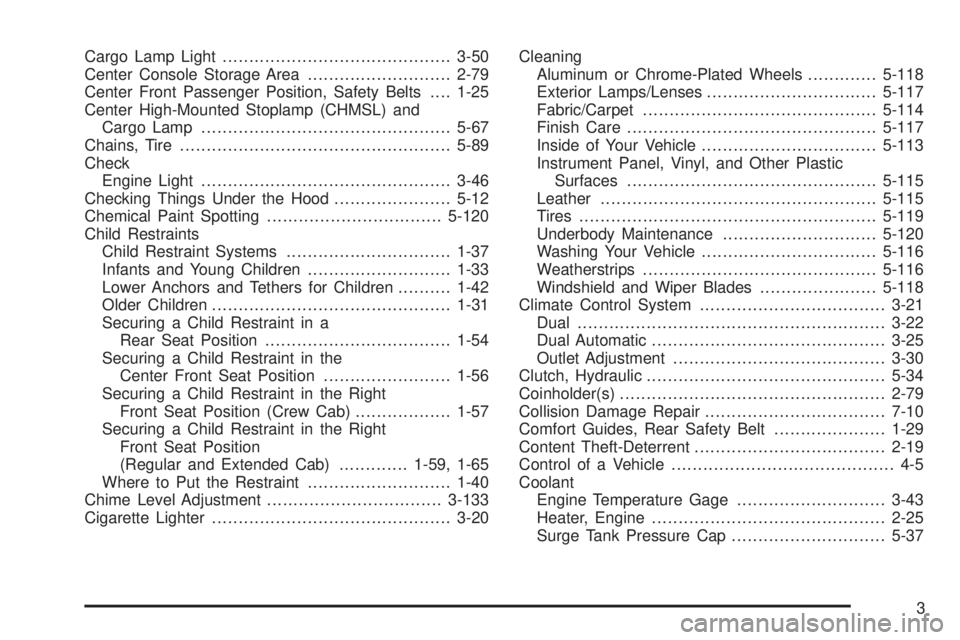
Cargo Lamp Light...........................................3-50
Center Console Storage Area...........................2-79
Center Front Passenger Position, Safety Belts....1-25
Center High-Mounted Stoplamp (CHMSL) and
Cargo Lamp...............................................5-67
Chains, Tire...................................................5-89
Check
Engine Light...............................................3-46
Checking Things Under the Hood......................5-12
Chemical Paint Spotting.................................5-120
Child Restraints
Child Restraint Systems...............................1-37
Infants and Young Children...........................1-33
Lower Anchors and Tethers for Children..........1-42
Older Children.............................................1-31
Securing a Child Restraint in a
Rear Seat Position...................................1-54
Securing a Child Restraint in the
Center Front Seat Position........................1-56
Securing a Child Restraint in the Right
Front Seat Position (Crew Cab)..................1-57
Securing a Child Restraint in the Right
Front Seat Position
(Regular and Extended Cab).............1-59, 1-65
Where to Put the Restraint...........................1-40
Chime Level Adjustment.................................3-133
Cigarette Lighter.............................................3-20Cleaning
Aluminum or Chrome-Plated Wheels.............5-118
Exterior Lamps/Lenses................................5-117
Fabric/Carpet............................................5-114
Finish Care...............................................5-117
Inside of Your Vehicle.................................5-113
Instrument Panel, Vinyl, and Other Plastic
Surfaces...............................................5-115
Leather....................................................5-115
Tires........................................................5-119
Underbody Maintenance.............................5-120
Washing Your Vehicle.................................5-116
Weatherstrips............................................5-116
Windshield and Wiper Blades......................5-118
Climate Control System...................................3-21
Dual..........................................................3-22
Dual Automatic............................................3-25
Outlet Adjustment........................................3-30
Clutch, Hydraulic.............................................5-34
Coinholder(s)..................................................2-79
Collision Damage Repair..................................7-10
Comfort Guides, Rear Safety Belt.....................1-29
Content Theft-Deterrent....................................2-19
Control of a Vehicle.......................................... 4-5
Coolant
Engine Temperature Gage............................3-43
Heater, Engine............................................2-25
Surge Tank Pressure Cap.............................5-37
3
Page 590 of 600
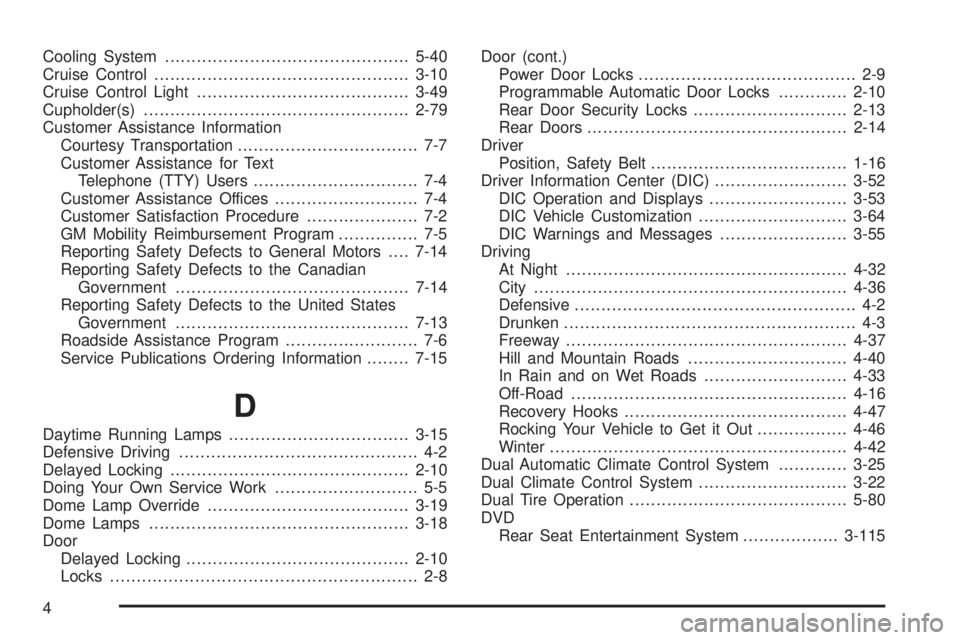
Cooling System..............................................5-40
Cruise Control................................................3-10
Cruise Control Light........................................3-49
Cupholder(s)..................................................2-79
Customer Assistance Information
Courtesy Transportation.................................. 7-7
Customer Assistance for Text
Telephone (TTY) Users............................... 7-4
Customer Assistance Offices........................... 7-4
Customer Satisfaction Procedure..................... 7-2
GM Mobility Reimbursement Program............... 7-5
Reporting Safety Defects to General Motors....7-14
Reporting Safety Defects to the Canadian
Government............................................7-14
Reporting Safety Defects to the United States
Government............................................7-13
Roadside Assistance Program......................... 7-6
Service Publications Ordering Information........7-15
D
Daytime Running Lamps..................................3-15
Defensive Driving............................................. 4-2
Delayed Locking.............................................2-10
Doing Your Own Service Work........................... 5-5
Dome Lamp Override......................................3-19
Dome Lamps.................................................3-18
Door
Delayed Locking..........................................2-10
Locks.......................................................... 2-8Door (cont.)
Power Door Locks......................................... 2-9
Programmable Automatic Door Locks.............2-10
Rear Door Security Locks.............................2-13
Rear Doors.................................................2-14
Driver
Position, Safety Belt.....................................1-16
Driver Information Center (DIC).........................3-52
DIC Operation and Displays..........................3-53
DIC Vehicle Customization............................3-64
DIC Warnings and Messages........................3-55
Driving
At Night.....................................................4-32
City...........................................................4-36
Defensive..................................................... 4-2
Drunken....................................................... 4-3
Freeway.....................................................4-37
Hill and Mountain Roads..............................4-40
In Rain and on Wet Roads...........................4-33
Off-Road....................................................4-16
Recovery Hooks..........................................4-47
Rocking Your Vehicle to Get it Out.................4-46
Winter........................................................4-42
Dual Automatic Climate Control System.............3-25
Dual Climate Control System............................3-22
Dual Tire Operation.........................................5-80
DVD
Rear Seat Entertainment System..................3-115
4